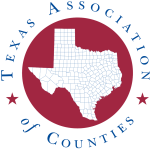County Magazine | April 30, 2024
First Amendment auditors raise issues for counties
Recent confrontations have prompted changes in policies

Grayson County Courthouse in September 2023,
recording himself asking county employees about
personal information. (Credit: Grayson County)
In September, a man wearing a black ski mask and dark glasses walked into the Grayson County Courthouse and began asking employees about where they live and how much money they make, speaking in a fake Middle Eastern accent. He held a phone in one hand, recording video of everything.
He pointed to columns in the historic courthouse and asked whether they were integral to the original structure. Frightened workers called the sheriff’s office, and responding deputies trailed the man as he went around the building, still recording.
Grayson County Judge Bruce Dawsey said he thinks that was the first time a so-called First Amendment auditor visited the courthouse, leading to fear and confusion, but the trend of recording public workers – particularly police officers – in governmental buildings began about a decade ago. The auditors, who claim to be exercising their First Amendment rights, try to elicit a confrontation with the staff and then post the videos online, generating views and revenue from ads.
“Some are a little more passive in exercising their rights. Others are really there to badger and try to create disruption, and some push the envelope,” said Thomas Kerss, Texas Association of Counties Law Enforcement & Simulator Consultants Supervisor who trains counties on how to handle First Amendment auditors. “They’re really selling their experiences on social media. The more views they get, the more hits or likes, the more ads they can sell.”
In Brazos County, auditors who visited the sheriff’s office in 2021 posted the video to YouTube under the account “FoulMouth Veteran.” In the video, the auditors walk around outside the facility and inside the lobby before having a friendly conversation with several deputies in the parking lot.
“They see how many different locations they can go into. They won’t go behind any secured facilities, but anywhere the public has access, they’re going to try to gain access to, and what they’re looking for is somebody to confront them,” said Brazos County Chief Deputy Paul Martinez. “When they don’t get the confrontation, they don’t stay very long.”
The Grayson County deputies who responded realized what the man was doing and that he didn’t pose a threat, but his visit frightened many employees, which led the commissioners court to convene a committee to survey the security of county buildings. County staff also received training on how to respond to First Amendment auditors and installed “employees only” signage on private work spaces and offices. Kerss began offering training to counties in 2022 to help officials understand how to avoid confrontations with auditors. He said that although members of the public – including auditors – have a right to be in a public facility, they don’t have a right to enter and record everywhere, such as in restrooms and individual work spaces.
“Preparation is really understanding what their rights are and understanding what their limitations are,” he said.
Kerss said First Amendment auditors are looking for obvious barriers to stop them from entering, but the challenge is that no two county buildings are the same. Every county must survey its facilities and determine its private and public spaces, labeling areas that are off limits to the public. There’s no special language to use, but signs make enforcing violations easier.
“We’ve made a very concerted effort at TAC to try and help educate our counties across the state on what the general dos and don’ts are,” he said. “No county is too big or too small to be ignored by an auditor. No county is too far or too remote. They will travel far and wide.”

